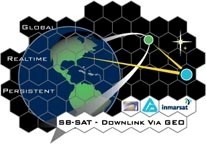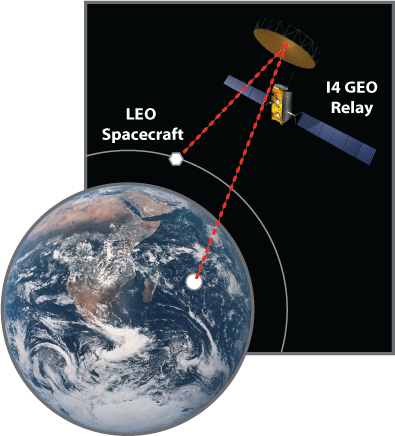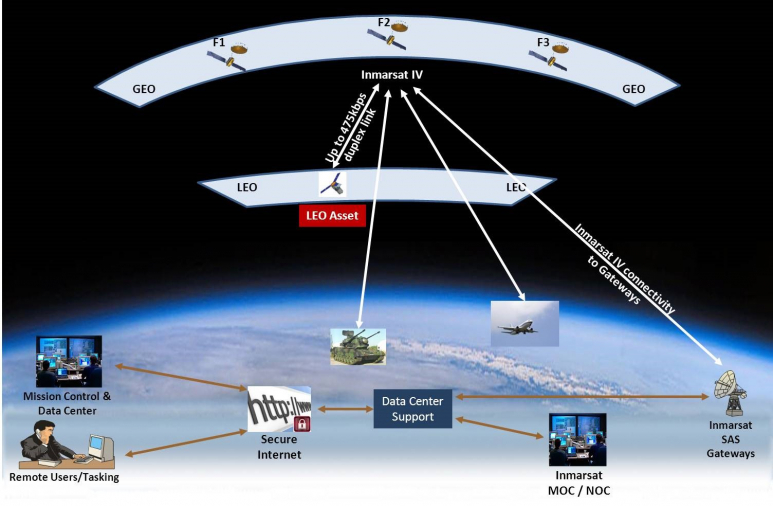
-
StatusCompleted
-
Status date2017-03-08
-
Activity Code5C.136
Existing communication systems for LEO spacecraft are limited to the ground station overpass period (approximately ten minutes per orbit). To use this extremely limited but vital communications link, satellite operators must invest in very expensive ground segment infrastructure, or lease dedicated facilities. The operational features of this arrangement dictate the use of on-board data storage and often lead to ‘out-of-date’ data.
SB-SAT allows space borne terminals to send signals to the Inmarsat constellation in geostationary Earth orbit (GEO). The Inmarsat satellites then relay the signals through Inmarsat ground stations to users or operators, making full use of Inmarsat’s mobile broadband system infrastructure. The user application layer is fully accessible from anywhere on the globe through a secure Internet connection.

The SB-SAT ARTES 3-4 project objectives were therefore to develop the SB-SAT terminal hardware capable of deployment on a range of spacecraft and the associated BGAN service infrastructure upgrade to support its operation. This would revolutionise the way that satellite operators access LEO spacecraft by enabling continuous, near real-time communications.
For SB-SAT to operate within the existing Inmarsat BGAN network, precise GPS based knowledge of actual spacecraft dynamics is essential to pinpoint the Inmarsat GEO assets, perform Doppler correction and correct return burst timing, allowing SB-SAT to coexist with the current user terminal population. Those functions are performed largely by the terminal. High-rate spot-beam handover within the Inmarsat I-4 satellite footprint needs to be performed predictively in close coordination with the upgraded Inmarsat BGAN core network.
SB-SAT offers an affordable 24/7 communication service to Low Earth Orbit (LEO) spacecraft through direct access to the BGAN core global network. It allows the setting up and maintaining an of an IP connection between the SB-SAT terminal serving the LEO spacecraft and the SB-SAT customer server anywhere around the globe.
The key system features offered by SB-SAT are:
- Use of the existing Inmarsat communications infrastructure
- Near real-time continuous communications
- On-demand service utilisation
- No requirement for a new frequency license
- No provisioning delay – stand-by possible
- Secure access from anywhere on Earth via the Internet
- Reduced operational costs
- Equipment designed specifically for spacecraft applications
The SB-SAT system consists of three elements:
- The Inmarsat I-4 constellation of GEO satellites
- The Inmarsat Broadband Global Area Network (BGAN) and service infrastructure
- The SB-SAT terminal hardware and software deployed on any LEO asset
The Inmarsat I-4 constellation provides communications services to user equipment using a combination of global, regional, and spot beams. Originally designed to service ground, maritime, and aeronautical users, the BGAN system and ground infrastructure can now be extended to cover space-based terminals at LEO.
 In the SB-SAT architecture the LEO asset hosts an SB-SAT terminal which communicates with the I-4 satellite. The SB-SAT terminal installed on the LEO utilises the existing Inmarsat I-4 constellation and BGAN ground network capabilities just like any other Inmarsat BGAN terminal. The Inmarsat network relies on the terminal to adjust its transmit and receive characteristics to fit seamlessly into the existing BGAN system.
In the SB-SAT architecture the LEO asset hosts an SB-SAT terminal which communicates with the I-4 satellite. The SB-SAT terminal installed on the LEO utilises the existing Inmarsat I-4 constellation and BGAN ground network capabilities just like any other Inmarsat BGAN terminal. The Inmarsat network relies on the terminal to adjust its transmit and receive characteristics to fit seamlessly into the existing BGAN system.
The development was structured into two main stages:
Phase 1: Ground prototype development & validation
This phase consisted of the requirements development, architecture development, system design, and specification followed by an early implementation of the SB-SAT system in prototype form using a breadboard version of the user terminal.
Phase 2: Engineering unit build and qualification
This phase covered the development and testing of an engineering qualification terminal using the same build standard as a flight unit. The phase culminated in a set of regression tests with the Inmarsat test suites and the live Inmarsat BGAN network and full environmental qualification of the terminal hardware.
Complete.
The terminal has completed the necessary environmental tests and functional tests with the Inmarsat BGAN network necessary for flight.
Development of all Inmarsat ground network sub-systems and testing of the Ground Network chain is as complete as possible pre-flight.
Pre-flight activities necessary for integration onto a specific spacecraft have been identified together with the necessary ground network tests which can only be verified in flight.




